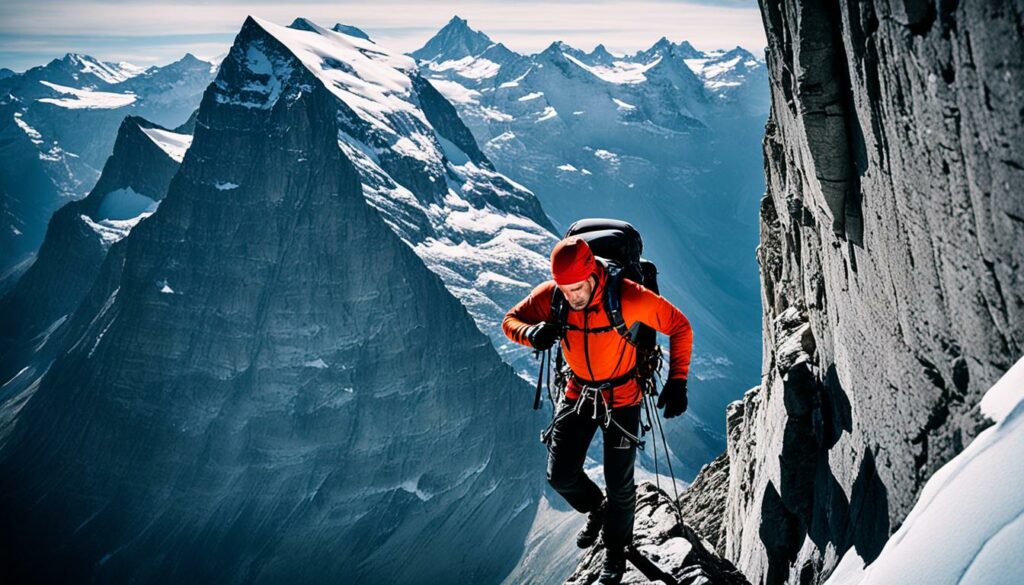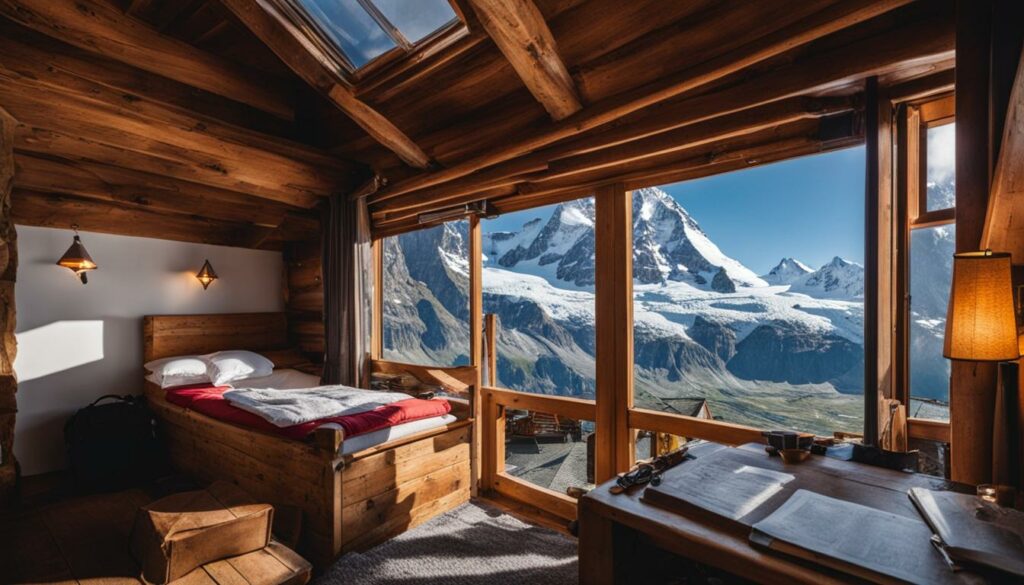“The best view comes after the hardest climb.” – Unknown
Welcome to our guide on climbing the majestic Eiger mountain in Switzerland. As one of the most iconic peaks in the Bernese Oberland, the Eiger offers a thrilling adventure for mountaineers. With its multiple routes to the summit, each presenting its own challenges and rewards, choosing the right path can make all the difference in your climbing experience.
Key Takeaways:
- Explore the different routes of the Eiger to find the one that suits your skills and preferences.
- Prepare physically and mentally for the challenges that await you on the mountain.
- Consider the weather and seasonal conditions to choose the best time for your climb.
- Make sure to have the necessary climbing gear and knowledge of its proper usage.
- Prioritize safety by climbing with an experienced guide and being prepared for emergencies.
The Majestic Eiger Mountain
The Eiger is a prominent peak in the Swiss Alps, standing at an elevation of 3,967 meters. It is a breathtaking mountain that captivates climbers from around the world. Known for its impressive features and challenging routes, the Eiger offers an unforgettable mountaineering experience.
Iconic Features of the Eiger
The Eiger is renowned for several notable features that contribute to its allure among climbers:
- Eiger North Face: The north face of the Eiger, also known as Nordwand, is one of the most treacherous and sought-after climbing routes in the world. Its sheer verticality, unpredictable weather, and technical challenges make it an ultimate test for experienced climbers.
- Eiger Mittellegi Ridge: The Mittellegi ridge is a striking arête that extends from the Eiger’s summit. This iconic feature offers a thrilling traverse with breathtaking exposure and stunning views of surrounding peaks.
- Eiger West Flank: The west flank of the Eiger presents a demanding and less frequented route. This challenging face requires climbers to navigate complex terrain, including icefields, seracs, and steep walls.
“The Eiger is a mountain that demands respect and rewards climbers with unforgettable challenges and majestic landscapes.”
The combination of these awe-inspiring elements makes the Eiger a dream destination for mountaineers seeking the ultimate adrenaline rush and a true sense of accomplishment.
Decoding the Routes of Eiger
When it comes to climbing the Eiger, adventurers are presented with a range of routes, each offering its own set of challenges and rewards. Understanding the difficulties and requirements of each route is essential for a successful climb. Let’s take a closer look at the different routes available:
The North Face: A Thrilling Challenge
The Eiger’s imposing north face is considered one of the most challenging routes in the world. With its sheer verticality and unpredictable weather conditions, climbers must possess advanced technical skills, high endurance, and an unwavering determination to conquer this iconic face.
The Mittellegi Ridge: Scenic and Accessible
The Mittellegi ridge presents a captivating and accessible route for climbers. Offering breathtaking panoramic views, this traverse involves a combination of rock climbing, ridge walking, and glacier travel. Although less technically demanding than the north face, it still requires a solid set of mountaineering skills and a good level of fitness.
The South Ridge: A Classic and Varied Option
The south ridge provides a classic and varied climbing experience. It combines rock, snow, and ice sections, offering a well-rounded challenge. Climbers must navigate exposed ridges, negotiate steep snow slopes, and conquer technical sections. A solid grasp of climbing techniques, glacier travel, and rope management is necessary for a successful ascent.
Embarking on an Eiger climbing adventure requires careful consideration of these routes, taking into account your skill level, experience, and personal goals. It is highly recommended to consult a knowledgeable climbing guide or reference a reputable climbing guidebook to ensure a safe and rewarding experience.
Beginning Your Journey to the Eiger
Embarking on your Eiger climbing adventure starts with reaching the picturesque village of Grindelwald in Switzerland. Situated in the Bernese Oberland region, Grindelwald serves as the starting point for accessing this iconic mountain.
The most convenient way to get to Grindelwald is by flying into Geneva International Airport. From there, you can enjoy a scenic drive or take a train ride through the stunning Swiss countryside to reach the village. The journey itself is a delightful experience, offering breathtaking views of lakes, mountains, and charming Swiss towns.
Once you arrive in Grindelwald, you can access different parts of the Eiger by taking the Jungfraubahn train. This historic railway takes you through the heart of the Swiss Alps, offering unparalleled views of the surrounding peaks and glaciers. Whether you’re heading to the north face, the south ridge, or any other section of the Eiger, the Jungfraubahn train provides convenient and scenic access.
Timing Your Climb
When it comes to climbing the Eiger, timing is everything. The duration of your climb will depend on the route you choose and your personal preferences. On average, it takes around two to three days to summit the Eiger. However, this can vary depending on factors such as weather conditions and your fitness level.
If you’re looking for a guided climbing experience, there are various options available. Some companies offer two-day ascents, allowing you to reach the summit and return in a shorter timeframe. For those seeking a more extensive adventure, there are also multi-day expeditions that combine climbing the Eiger with other nearby peaks.
Guided Climbing Options:
- Two-day ascents
- Multi-day expeditions
It’s important to carefully plan and select the duration that suits your skill level and objectives. Whether you choose a shorter climb or a longer expedition, the experience of climbing the Eiger will be a rewarding and unforgettable journey.
Exploring the Routes of Eiger
The Eiger offers several popular climbing routes, each with its own unique challenges and rewards. Whether you’re seeking an adrenaline-pumping adventure or a more accessible ascent, the Eiger has something for every avid climber. Let’s dive into the details of the four main routes: the Mittellegi ridge, the north face (Nordwand), the south ridge, and the west flank.
Eiger Mittellegi Ridge
The Eiger Mittellegi ridge route is renowned for its panoramic views and exposed arête climbing. This route is a favorite among experienced mountaineers seeking a thrilling and technically demanding ascent. The ridge spans approximately 1,200 meters and poses challenges such as steep couloirs, mixed rock and ice sections, and traverses along a narrow ridge. Climbing the Eiger via the Mittellegi ridge offers a truly unforgettable experience.
Eiger North Face (Nordwand)
Standing as one of the most infamous and challenging routes in the world, the Eiger north face demands the highest level of skill and expertise. It has earned a fearsome reputation due to its steepness, rockfall danger, and unpredictable weather conditions. Climbing the north face requires navigating dangerous ice slopes, overhangs, and complex mixed terrain. Only experienced climbers with advanced technical abilities should attempt this route.
Eiger South Ridge
The Eiger’s south ridge provides a less demanding alternative to the north face while still offering a rewarding climbing experience. The route starts from the Mönchsjoch Hut and involves exposed rock climbing, snow slopes, and ridge traverses. Although less technically challenging than the north face, climbers should still possess solid mountaineering skills and experience. The south ridge offers breathtaking views and a sense of achievement upon reaching the summit.
Eiger West Flank
The west flank route of the Eiger offers a less technically difficult option compared to the north face. It involves traversing glacier terrain, ascending snow slopes, and navigating mixed rock and ice sections. While it is considered one of the easier routes on the Eiger, climbers should still have experience in alpine mountaineering and be prepared for challenging conditions. The west flank provides a fantastic opportunity to summit the iconic Eiger with a rewarding level of accomplishment.
Exploring the routes of Eiger allows climbers to choose a path that aligns with their skills, experience, and aspirations. It is crucial to assess your abilities honestly and pick a route that matches your capabilities. Remember, safety should always be the top priority when embarking on an Eiger climbing adventure.
| Route | Difficulty | Highlights |
|---|---|---|
| Eiger Mittellegi Ridge | Difficult | Panoramic views, exposed arête climbing |
| Eiger North Face (Nordwand) | Extremely difficult | Infamous challenge, steep and dangerous terrain |
| Eiger South Ridge | Moderate to difficult | Breathtaking views, rewarding climbing experience |
| Eiger West Flank | Moderate | Easier option, traversing glacier terrain |
Getting Physically Ready for Eiger
Preparing for a successful climb up the Eiger requires a high level of physical fitness and prior mountaineering experience. To ensure you are physically ready for this challenging adventure, it is essential to undertake a comprehensive training regimen that targets specific areas of physical conditioning.
Eiger Physical Requirements
Climbing the Eiger demands considerable strength, endurance, and agility. This iconic mountain presents climbers with steep ascents, challenging rock faces, and unpredictable weather conditions. To conquer these obstacles, you must focus on building the following physical attributes:
- Cardiovascular endurance: Engage in activities such as running, cycling, or swimming to enhance your heart and lung capacity. This will help you maintain a steady pace and cope with the demands of prolonged exertion at high altitudes.
- Muscular strength: Incorporate strength training exercises targeting the core, arms, legs, and upper body. Strengthening these muscle groups will provide the necessary power to overcome steep inclines, traverse rocky terrains, and handle the weight of your climbing gear.
- Flexibility: Practice stretching exercises to improve flexibility and prevent injuries. Adequate flexibility is crucial for navigating through tight spaces, maintaining balance, and executing precise movements during the climb.
Remember, a gradual progression in training intensity is vital to avoid overexertion and injury. Consult with a fitness professional to design a training plan tailored to your fitness level and specific requirements.
Eiger Climbing Preparation
Prioritize preparation before you embark on your Eiger climbing adventure. Taking the following steps will contribute to a safer and more enjoyable experience:
- Gain mountaineering experience: Familiarize yourself with mountaineering techniques by participating in guided climbs, attending courses, or joining a climbing club. This practical experience will help you develop essential skills and boost your confidence on the mountain.
- Study route details: Thoroughly research the Eiger climbing routes and their respective challenges. Understanding the route’s technical requirements, dangers, and potential hazards will equip you with the necessary knowledge to make informed decisions during the climb.
- Acclimate to high altitudes: Consider acclimatization training, which involves gradually exposing yourself to higher altitudes to allow your body to adapt to reduced oxygen levels. This process significantly reduces the risk of altitude-related illnesses and improves your overall performance.
By dedicating time to physical training and preparation, you will enhance your climbing abilities and increase your chances of reaching the summit of the Eiger.

Eiger Fitness Training
A well-rounded fitness training program is essential for conquering the physical challenges of climbing the Eiger. Consider the following components to include in your training regimen:
- Climbing-specific exercises: Simulate Eiger-like conditions by incorporating exercises such as stair climbing, indoor rock climbing, or outdoor scrambling. These activities will improve your climbing technique, balance, and coordination.
- Strength and resistance training: Engage in weightlifting, bodyweight exercises, or specialized mountaineering exercises to strengthen key muscle groups. Focus on building upper body strength, lower body power, and core stability to improve overall climbing performance.
- Cardiovascular workouts: Perform high-intensity interval training (HIIT), hiking, or trail running to boost your endurance and cardiovascular fitness. These exercises help mimic the demands of climbing and improve your ability to sustain physical effort over long periods.
- Flexibility and mobility exercises: Dedicate time to stretching routines, yoga, or Pilates to improve flexibility, joint mobility, and overall body alignment. Increased flexibility enhances movement efficiency and reduces the risk of muscle strains or injuries.
It is crucial to gradually increase the intensity and duration of your training sessions to build stamina and prevent burnout. Additionally, consult with a fitness professional to ensure your training plan aligns with your climbing goals and individual needs.
Remember, physical conditioning is just one aspect of Eiger preparation. Building mental resilience, gathering the right gear, and staying informed about weather conditions are equally important for a successful ascent.
| Training Component | Recommended Frequency | Example Exercise |
|---|---|---|
| Strength Training | 2-3 times per week | Deadlifts, pull-ups, squats |
| Cardiovascular Endurance | 3-4 times per week | Running, cycling, swimming |
| Flexibility | Every day | Yoga, static stretching |
By diligently following a comprehensive training plan, you will significantly improve your physical capabilities and increase your chances of a successful Eiger climb. Remember to listen to your body, respect your limits, and enjoy the journey of preparing for this awe-inspiring adventure.
Weather and Seasonal Considerations
Climbing the majestic Eiger requires careful consideration of weather conditions and choosing the right season for your expedition. Understanding the Climbing Eiger weather conditions and the Eiger climbing season is crucial for a safe and successful climb.
The best time to climb the Eiger is during the summer months from June to September, except for the north face route. These months offer relatively warm temperatures at the summit, making it more comfortable for climbers. Additionally, the summer season usually has fewer rainy days, reducing the risk of encountering unfavorable weather conditions during your ascent.
“Climbing the Eiger in the summer months provides the best chance for good weather and favorable conditions. It’s important to avoid the north face route during this time due to increased rockfall and unpredictable weather. Winter mountaineering on the Eiger should only be attempted by advanced climbers due to the extreme conditions.”
However, if you’re an experienced climber looking for a unique challenge, winter mountaineering expeditions on the Eiger are possible. These expeditions require special skills and preparation to navigate the harsh conditions and sub-zero temperatures. It’s essential to have advanced mountaineering experience and be well-equipped with appropriate gear before attempting a winter climb on the Eiger.
Whether you choose the summer season for a more accessible climb or the winter season for an advanced mountaineering experience, understanding the weather conditions and selecting the right time to climb will significantly contribute to a safe and enjoyable Eiger adventure.
Gear Up for Eiger
When it comes to climbing the majestic Eiger, having the right gear is essential for a safe and successful ascent. Here are some of the essential pieces of equipment you’ll need:
“Having the proper gear can make all the difference in your Eiger climb. Invest in high-quality equipment and take the time to familiarize yourself with its proper usage.”
Mountaineering Boots
Choose sturdy and waterproof mountaineering boots to provide stability, insulation, and protection while climbing on various terrains.
Crampons
Crampons are crucial for gaining traction on icy surfaces. Opt for crampons with adjustable configurations to accommodate different boot sizes and terrain conditions.
Ice Axes
Ice axes help with balance, stability, and self-arrest techniques. Select ergonomic ice axes that are lightweight and durable.
Ropes
Strong and dynamic climbing ropes are essential for safety, belaying, and rappelling. Make sure to use ropes that are suitable for alpine climbing conditions.
Carabiners
Carabiners are used for attaching equipment, securing ropes, and setting up anchors. Choose lightweight yet robust carabiners that are easy to handle.
Harnesses
Select a climbing harness that offers comfort, adjustability, and durability. A well-fitted harness is vital for distributing weight and providing security during the climb.
Protective Clothing
Stay protected from extreme weather conditions with insulated layers, waterproof outerwear, gloves, and a reliable climbing helmet.
Having a complete and appropriate set of gear will give you the confidence to tackle the challenges that lie ahead on the Eiger. Remember, your safety should always be the top priority.
| Essential Gear for Eiger Climb | Recommended Brands |
|---|---|
| Mountaineering Boots | La Sportiva |
| Crampons | Black Diamond |
| Ice Axes | Petzl |
| Ropes | Mammut |
| Carabiners | Black Diamond |
| Harnesses | BD Alpine |
| Protective Clothing | Outdoor Research |
Resting in the Mountains
After a challenging day of climbing the iconic Eiger, it’s essential to find comfortable and convenient accommodation to rest and rejuvenate. Luckily, there are various options available for climbers near the Eiger, ensuring a well-deserved break in the picturesque Swiss Alps.
For those seeking an authentic mountaineering experience, mountain huts are an excellent choice. The Mittellegi Hut, situated at an altitude of 3,335 meters, offers breathtaking views and a rustic ambiance. It serves as a basecamp for climbers attempting the Eiger’s popular Mittellegi ridge route. Another option is the Mönchsjoch Hut, located at an elevation of 3,658 meters. This traditional mountain hut provides a cozy refuge for climbers tackling the Eiger’s north face route.
If you prefer a more comfortable stay, there are hotels and hostels available in the nearby towns of Grindelwald and Kleine Scheidegg. These accommodations offer modern amenities, warm hospitality, and convenient access to the Eiger. Whether you’re looking for a luxury hotel or a budget-friendly hostel, you can find suitable options that cater to your preferences.
When choosing your accommodation, consider the specific route you plan to climb. Selecting a place that offers easy access to your chosen route will save you time and energy. Additionally, check for availability and make reservations in advance, especially during peak climbing seasons.
Rest assured, after a good night’s sleep in the mountains, you’ll be ready to tackle the next leg of your Eiger adventure.

Ensuring Safety on the Eiger
Climbing the Eiger is an exhilarating adventure, but it comes with inherent risks that should not be taken lightly. Prioritizing safety is crucial to ensure a successful and enjoyable climb. Here are some important safety precautions to consider:
- Climb with an experienced guide: It is highly recommended to climb the Eiger with the assistance of an experienced and certified mountain guide. They possess valuable knowledge of the routes, weather conditions, and emergency procedures, reducing the risks involved.
- Assess weather conditions: Stay updated on the weather forecast before your climb. Unfavorable weather conditions such as strong winds, heavy rainfall, or snowstorms can significantly impact your safety. Make informed decisions and be prepared to postpone or adjust your plans accordingly.
- Carry proper safety equipment: Ensure you have the necessary safety equipment, including helmets, harnesses, ropes, carabiners, and crampons. These items are essential for protection and stability during your ascent. Familiarize yourself with their proper usage and maintenance.
- Be prepared for emergencies: Climbing the Eiger can pose unexpected challenges. Carry a first aid kit, emergency communication devices, and extra provisions in case of any unforeseen circumstances. It is essential to have the knowledge and skills to deal with emergencies, including self-rescue techniques.
- Adequate training and preparation: Before attempting the Eiger climb, undergo proper training and physical conditioning. Enhance your mountaineering skills, practice rope management, and learn relevant techniques for climbing on different terrains. Regularly engage in strength and endurance exercises to build your fitness level.
Remember, safety should always be your top priority. A well-planned and cautious approach will not only minimize risks but also maximize your chances of a successful climb on the majestic Eiger.
Tips for Safe Climbing on the Eiger
- Stay hydrated and well-nourished throughout the climb. Proper nutrition and hydration are essential for maintaining energy levels and mental focus.
- Take breaks and rest when needed. Pushing yourself beyond your limits can compromise your safety and increase the likelihood of accidents.
- Communicate with your climbing team and guide effectively. Clear and open communication is vital for coordination and safety during the climb.
- Follow Leave No Trace principles and respect the mountain environment. Minimize your impact on the natural surroundings and leave them as you found them.
- Continuously assess your own physical and mental state. Be aware of signs of altitude sickness, fatigue, or any discomfort that could hinder your climb. It is better to retreat and come back stronger another time than to risk your well-being.
By adhering to these safety precautions and guidelines, you can have a fulfilling and secure climbing experience on the awe-inspiring Eiger. Remember, your safety is in your hands, and proper planning and preparation are pivotal to a successful summit.
Seeking Professional Guidance
Hiring a climbing guide or enrolling in a climbing course can greatly enhance your Eiger climbing experience. Professional guides offer valuable expertise, safety measures, and local knowledge. There are various guided trips and courses available, ranging from two-day ascents to comprehensive multi-day programs. Choosing a reputable guide or course provider will ensure a well-guided and educational journey.
Benefits of Hiring Eiger Climbing Guides
When embarking on a challenging adventure like climbing the Eiger, having an experienced guide by your side can make all the difference. Here are some reasons why hiring an Eiger climbing guide is advantageous:
- Expertise and Knowledge: Eiger climbing guides possess in-depth knowledge of the mountain, its routes, and the local conditions. They can provide valuable insights, ensuring a safer and more successful ascent.
- Safety Measures: Professional guides prioritize safety and are trained to handle potential risks and emergencies. They can navigate challenging terrain, assess weather conditions, and implement necessary precautions.
- Local Insights: Guides familiar with the Eiger can offer insider tips, allowing you to make the most of your climb. They can share stories, history, and cultural significance related to the mountain, enriching your overall experience.
When selecting an Eiger climbing guide, consider factors such as their experience, certifications, and customer reviews. It is advisable to choose a guide who aligns with your skill level, goals, and preferences.
Eiger Climbing Courses
If you are looking for a more comprehensive learning experience, enrolling in an Eiger climbing course is an excellent option. These courses cater to climbers of various levels, providing training, instruction, and practice necessary for successful ascents. Here are some notable aspects of Eiger climbing courses:
- Skills Development: Eiger climbing courses focus on honing essential mountaineering skills, including rope techniques, rock climbing, glacier travel, and navigation. Participants have the opportunity to learn from experienced instructors and acquire new capabilities.
- Safety and Risk Management: Courses emphasize safety protocols, emergency preparedness, and risk assessment. Participants gain a comprehensive understanding of the potential dangers associated with climbing the Eiger and how to mitigate them.
- Practical Experience: Many courses offer hands-on training and guided climbs on the Eiger itself. This allows participants to apply their newly acquired skills and gain real-world experience under the supervision of instructors.
When choosing an Eiger climbing course, consider factors such as the course duration, curriculum, instructor qualifications, and participant-to-instructor ratio. It is essential to select a course that aligns with your current skill level and goals, ensuring a valuable and enriching learning experience.
**Table: Comparison of Eiger Climbing Guides and Courses**
| Criteria | Eiger Climbing Guides | Eiger Climbing Courses |
| ——————– | ———————————– | ———————————— |
| Expertise and Knowledge | Possess in-depth knowledge of the mountain, routes, and local conditions | Instructors share valuable insights and practical experience |
| Safety Measures | Prioritize safety and handle potential risks and emergencies | Teach safety protocols and risk management strategies |
| Local Insights | Provide insider tips and enrich the overall experience | Offer cultural significance and historical narratives |
| Skills Development | N/A | Focus on honing essential climbing skills |
| Practical Experience | N/A | Provide guided climbs on the Eiger |
When deciding between hiring a guide and enrolling in a course, consider your individual preferences, goals, and previous climbing experience. Both options offer unique benefits, and the choice ultimately depends on what you hope to achieve during your Eiger climbing adventure.
Concluding Your Eiger Adventure
Climbing the Eiger is a challenging and exhilarating endeavor. To ensure a successful and memorable climb, here are some final tips:
1. Select the right route: Consider your skill level, experience, and personal preferences when choosing the route. Research each option thoroughly and consult with experienced climbers or local guides for advice.
2. Adequate preparation: Prepare yourself physically and mentally for the climb. Follow a comprehensive training regimen that includes climbing conditioning, strength training, cardiovascular exercises, and flexibility training. Familiarize yourself with the gear and equipment required and practice using them before the climb.
3. Ensure safety: Climbing the Eiger involves inherent risks, so prioritize safety. Always climb with an experienced guide who is familiar with the mountain and its conditions. Stay updated on weather conditions and adjust your plans accordingly. Carry proper safety equipment and be prepared for emergency situations.
As you embark on this adventure, don’t forget to take a moment to appreciate the stunning natural beauty of the Bernese Oberland. Enjoy the unique experience of climbing this iconic mountain, and make memories that will last a lifetime.



